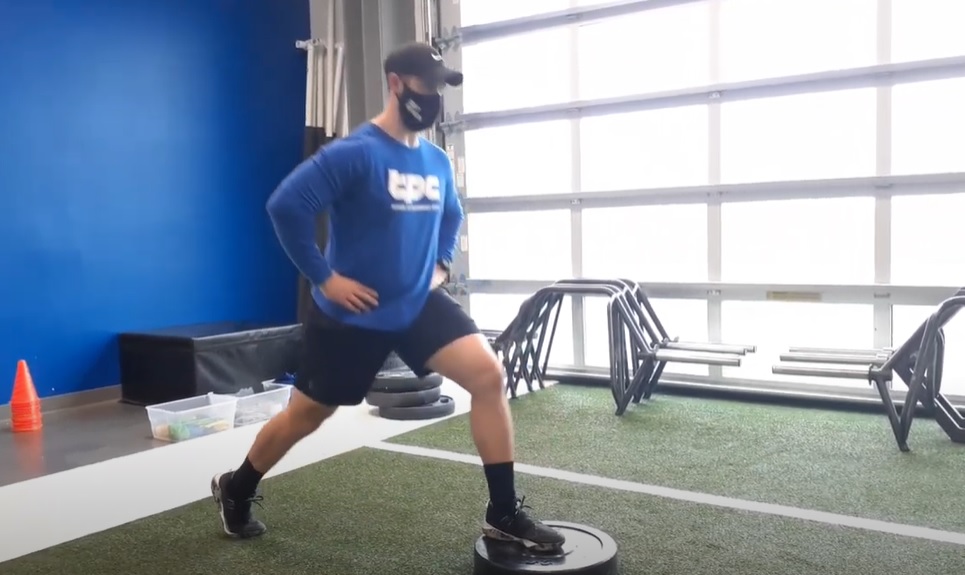The Front Foot Elevated Split Squat (FFESS) is a compound exercise that targets the quads, hamstrings, and glutes. It’s a great move for building lower-body strength and size. The FFESS can be performed with dumbbells, barbells, or kettlebells.
To do the FFESS, start by standing with your feet shoulder-width apart and one foot elevated on a bench or box. Hold a weight in each hand and keep your core engaged. Lower your body down into a lunge position until your front thigh is parallel to the ground.
Return to the starting position and repeat on the other side.
There are a lot of benefits to performing front foot elevated split squats. For one, they help to improve your balance and stability. Additionally, they target your quads, hamstrings, and glutes more effectively than traditional squats.
And lastly, they place less stress on your knees than other squat variations.
If you’re looking to add an exercise to your routine that will target your lower body muscles and help improve your overall strength and stability, then look no further than the front foot elevated split squat!

Credit: www.carlehealthfitness.com
Why Do Front Foot Elevated Split Squats?
There are many benefits to performing front foot elevated split squats. By elevating your front foot, you force your rear leg to work harder in order to maintain balance. This in turn activates more muscles and results in a greater level of muscle recruitment overall.
Additionally, this exercise is excellent for building single-leg strength and improving stability.
Another key benefit of front foot elevated split squats is that they place less stress on the knees than traditional back squat variations. This makes them an ideal exercise for those with knee injuries or pain.
And finally, because the range of motion is smaller compared to other squat exercises, front foot elevated split squats can be a great way to gradually build up strength and mobility before progressing to more advanced movements.
What Do Elevated Split Squats Do?
Elevated split squats are a great way to build strength and stability in the lower body. They are often used as a part of rehabilitation programs following an injury, or to help prevent injuries from occurring in the first place.
Split squats can be performed with either one leg on an elevated surface, such as a step or bench, or with both legs on an elevated surface.
When performed with both legs on an elevated surface, they are sometimes referred to as Bulgarian split squats.
The key benefits of performing elevated split squats include:
-Increased lower body strength
-Improved stability and balance
-Greater range of motion in the hips and knees
-Reduced risk of injury
There are a few things to keep in mind when performing elevated split squats: First, make sure that your front knee does not extend past your toes when lowering into the squat. Second, keep your torso upright throughout the movement – do not let it lean forward too much. Third, use slow and controlled movements – do not try to “explode” out of the bottom position.
And finally, focus on quality over quantity – it is better to perform fewer reps with perfect form than it is to perform more reps with poor form.
Are Elevated Split Squats Better?
If you’re wondering whether elevated split squats are better than traditional split squats, the answer is… it depends. Both exercises have their own benefits, so it really comes down to what your goals are.
Elevated split squats tend to be more challenging since your back leg is raised on a step or bench.
This forces your front leg to do more work, making it a great exercise for building strength and muscle in the quads and glutes.
Traditional split squats, on the other hand, tend to be a bit easier since both feet are on the ground. This makes them a great option if you’re looking to increase your range of motion or focus more on balance and stability.
So, which exercise is right for you? If you’re looking to build strength and muscle in your lower body, go with elevated split squats. If you want to focus on balance and stability, traditional split squats are probably a better choice.
How High Should Foot Be Elevated for Bulgarian Split Squat?
When performing a Bulgarian split squat, your foot should be elevated on a surface that is approximately 12 inches high. This elevation will place your center of gravity over your front leg, allowing you to effectively perform the exercise. If your foot is not elevated high enough, you will not be able to properly execute the movement and may put undue stress on your knees.
Split Squat – Front Foot Elevated – DB | KILO Exercise Database
Front Foot Elevated Split Squat Muscles Worked
The front foot elevated split squat is a great exercise for targeting the muscles in your lower body. This move works your quads, hamstrings, glutes, and core. To do this exercise, start by standing with one foot in front of the other with your feet shoulder-width apart.
Place your back foot on an elevated surface behind you. Lower yourself down into a lunge position until both legs are at 90-degree angles. Make sure to keep your chest up and shoulders back throughout the entire movement.
Return to the starting position and repeat for desired reps.
Conclusion
The Front Foot Elevated Split Squat is a great exercise for building strength and power in the legs. It can be performed with either dumbbells or a barbell, and is a great addition to any leg workout. To perform the Front Foot Elevated Split Squat, start by placing your front foot on an elevated surface (such as a bench or box) and your back foot behind you.
Lower yourself down into a lunge position, keeping your front knee over your front ankle and your back straight. From here, drive through your front heel to return to the starting position.









